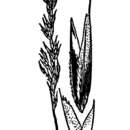Comprehensive Description
provided by North American Flora
Muhlenbergia filiculmis Vasey, Contr. U. S. Nat. Herb. 1 : 267. 1893.
Perennial; culms densely tufted, erect, filiform, glabrous, 10-20 cm. tall, the leaves in a short basal cluster; sheaths glabrous, the lower pale, becoming loose and more or less flattened, strongly and closely nerved; ligule prominent, pale, acute, 3-4 mm. long; blades involute, slender, often curved, firm, scabrous, sharp-pointed, 2-5 cm. long, rarely as much as 10 cm.; panicles narrow, erect, pale, terminating the culms, 1-5 cm. long, rarely longer, the somewhat distant branches appressed, the axis glabrous or nearly so, the branches and short pedicels (the lateral 0.5 mm. long or less) minutely scaberulous; glumes broad, the first abruptly awn-tipped, the body about I mm. long, the second 3-nerved, a little longer than the first, sharply 3-toothed, rarely entire or erose only; lemma lanceolate-terete, pubescent on the lower half, tapering to an awned tip, the body 2.5-3 mm. long.
Type locality: Green Mountain Falls, Colorado (Sheldon 321).
Distribution: Open sandy or rocky soil. 2000-3000 meters altitude, Wyoming. Colorado, and New Mexico.
- bibliographic citation
- Albert Spear Hitchcock. 1935. (POALES); POACEAE (pars). North American flora. vol 17(6). New York Botanical Garden, New York, NY
Physical Description
provided by USDA PLANTS text
Perennials, Terrestrial, not aquatic, Stems nodes swollen or brittle, Stems erect or ascending, Stems caespitose, tufted, or clustered, Stems terete, rou nd in cross section, or polygonal, Stem internodes hollow, Stems with inflorescence less than 1 m tall, Stems, culms, or scapes exceeding basal leaves, Leaves mostly basal, below middle of stem, Leaves mostly cauline, Leaves conspicuously 2-ranked, distichous, Leaves sheathing at base, Leaf sheath mostly open, or loose, Leaf sheath smooth, glabrous, Leaf sheath and blade differentiated, Leaf blades linear, Leaf blades subulate, needle-like, tip pungent, Leaf blades very narrow or filiform, less than 2 mm wide, Leaf blade margins folded, involute, or conduplicate, Leaf blades mostly glabrous, Leaf blades scabrous, roughened, or wrinkled, Ligule present, Ligule an unfringed eciliate membrane, Inflorescence terminal, Inflorescence a contracted panicle, narrowly paniculate, branches appressed or ascending, Inflorescence solitary, with 1 spike, fascicle, glomerule, head, or cluster per stem or culm, Inflorescence spike linear or cylindric, several times longer than wide, Inflo rescence branches more than 10 to numerous, Flowers bisexual, Spikelets pedicellate, Spikelets laterally compressed, Spikelet less than 3 mm wide, Spikelets with 1 fertile floret, Spikelets solitary at rachis nodes, Spikelets all alike and fertille, Spikelets bisexual, Spikelets disarticulating above the glumes, glumes persistent, Spikelets disarticulating beneath or between the florets, Rachilla or pedicel glabrous, Glumes present, empty bracts, Glumes 2 clearly present, Glumes equal or subequal, Glumes shorter than adjacent lemma, Glumes awned, awn 1-5 mm or longer, Glumes 1 nerved, Glumes 3 nerved, Glumes prominently lobed, Lemmas thin, chartaceous, hyaline, cartilaginous, or membranous, Lemma similar in texture to glumes, Lemma 3 nerved, Lemma glabrous, Lemma apex acute or acuminate, Lemma distinctly awned, more than 2-3 mm, Lemma with 1 awn, Lemma awn less than 1 cm long, Lemma awned from tip, Lemma awns straight or curved to base, Lemma margins thin, lying flat, Lemma straight, Callus or base of lemma evidently hairy, Callus hairs shorter than lemma, Palea present, well developed, Palea membranous, hyaline, Palea about equal to lemma, Palea 2 nerved or 2 keeled, Stamens 3, Styles 2-fid, deeply 2-branched, Stigmas 2, Fruit - caryopsis, Caryopsis ellipsoid, longitudinally grooved, hilum long-linear.

